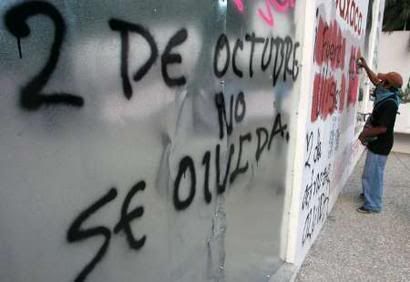40 Years After the Massacre - No Se Olvida
Thanks: Mictlan Murals
Melinna Teatrina
><///>
Date: Oct 2, 2007 12:28 PM

The massacre was preceded by months of political unrest in the Mexican capital, echoing student demonstrations and riots all over the world during 1968. The students wanted to exploit the attention focused on Mexico City for the 1968 Summer Olympics. President Gustavo Díaz Ordaz, however, was determined to stop the demonstrations and, in September, he ordered the army to occupy the campus of the National Autonomous University of Mexico, the country's largest university. Students were beaten and arrested indiscriminately. Rector Javier Barros Sierra resigned in protest on September 23.
Student demonstrators were not deterred, however. The demonstrations grew in size, until, on October 2, after student strikes lasting nine weeks, 15,000 students from various universities marched through the streets of Mexico City, carrying red carnations to protest the army's occupation of the university campus. By nightfall, 5,000 students and workers, many of them with spouses and children, had congregated outside an apartment complex in the Plaza de las Tres Culturas in Tlatelolco for what was supposed to be a peaceful rally. Among their chants were ¡No queremos olimpiadas, queremos revolución! ("We don't want Olympic games, we want revolution!"). Rally organizers did not attempt to call off the protest when they noticed an increased military presence in the area.
The massacre began at sunset when police and military forces — equipped with armored cars and tanks — surrounded the square and began firing live rounds into the crowd, hitting not only the protestors, but also other people who were present for reasons unrelated to the demonstration. Demonstrators and passersby alike, including children, were caught in the fire; soon, mounds of bodies lay on the ground. The killing continued through the night, with soldiers carrying out mopping-up operations on a house-to-house basis in the apartment buildings adjacent to the square. Witnesses to the event claim that the bodies were later removed in garbage trucks.
The official government explanation of the incident was that armed provocateurs among the demonstrators, stationed in buildings overlooking the crowd, had begun the firefight. Suddenly finding themselves sniper targets, the security forces had simply returned fire in self-defense.
In October 1997, the Congress of Mexico established a committee to investigate the Tlatelolco massacre. The committee interviewed many political players involved in the massacre, including Luis Echeverría Álvarez, a former president who was Díaz Ordaz's minister of the interior at the time of the massacre. Echeverría admitted that the students had been unarmed, and also suggested that the military action was planned in advance, as a means to destroy the student movement.
In October 2003, the role of the U.S. government in the massacre came to light when the National Security Archive at George Washington University published a series of records from the CIA, the Pentagon, the State Department, the FBI and the White House which were released in response to Freedom of Information Act requests. However these claims do not show direct involvement in massacres of the students. Some suggest that the documents just show that the U.S. was concerned with security during the Olympics.
The documents detail:
that in response to Mexican government concerns over the security of the Olympic Games the Pentagon sent military radios, weapons, ammunition and riot control training material to Mexico before and during the crisis.
that the CIA station in Mexico City produced almost daily reports tracking developments within the university community and the Mexican government from July to October. Six days before the confrontation at Tlatelolco, both Echeverría and head of Federal Security (DFS) Fernando Gutiérrez Barrios told the CIA that "the situation will be under complete control very shortly".
that the Díaz Ordaz government "arranged" to have student leader Sócrates Campos Lemus accuse dissident PRI politicians such as Carlos Madrazo of funding and orchestrating the student movement.
In 1993 in remembrance of the 25th anniversary of the events a stele was dedicated with the names of few of the students and persons who lost their lives during the event [1].
In June 2006, an ailing, 84-year-old Echeverría was charged with genocide in connection with the massacre. He was placed under house arrest pending trial. In early July of that year, he was cleared of genocide charges, as the judge found that Echeverría could not be put on trial because the statute of limitations had expired.



0 Comments:
Post a Comment
<< Home